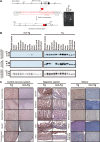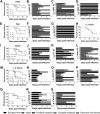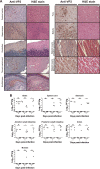A Novel Murine Model Expressing a Chimeric mSCARB2/hSCARB2 Receptor Is Highly Susceptible to Oral Infection with Clinical Isolates of Enterovirus 71
- PMID: 30894476
- PMCID: PMC6532076
- DOI: 10.1128/JVI.00183-19
A Novel Murine Model Expressing a Chimeric mSCARB2/hSCARB2 Receptor Is Highly Susceptible to Oral Infection with Clinical Isolates of Enterovirus 71
Abstract
Enterovirus 71 (EV71) infection is generally associated with hand-foot-and-mouth disease (HFMD) and may cause severe neurological disorders and even death. An effective murine oral infection model for studying the pathogenesis of various clinical EV71 isolates is lacking. We developed a transgenic (Tg) mouse that expresses an EV71 receptor, that is, human scavenger receptor class B member 2 (hSCARB2), in a pattern highly similar to that of endogenous murine SCARB2 (mSCARB2) protein. A FLAG-tagged SCARB2 cDNA fragment composed of exons 3 to 12 was inserted into a murine Scarb2 gene-containing bacterial artificial chromosome (BAC) clone, and the resulting transgene was used for establishment of chimeric receptor-expressing Tg mice. Tg mice intragastrically (i.g.) infected with clinical isolates of EV71 showed neurological symptoms, such as ataxia and paralysis, and fatality. There was an age-dependent decrease in susceptibility to viral infection. Pathological characteristics of the infected Tg mice resembled those of encephalomyelitis in human patients. Viral infection was accompanied by microglial activation. Clodronate treatment of the brain slices from Tg mice enhanced viral replication, while lipopolysaccharide treatment significantly inhibited it, suggesting an antiviral role for microglia during EV71 infection. Taken together, this Tg mouse provides a model that closely mimics natural infection for studying EV71 pathogenesis and for evaluating the efficacy of vaccines or other antiviral drugs.IMPORTANCE The availability of a murine model of EV71 infection is beneficial for the understanding of pathogenic mechanisms and the development and assessment of vaccines and antiviral drugs. However, the lack of a murine oral infection model thwarted the study of pathogenesis induced by clinically relevant EV71 strains that are transmitted via the oral-oral or oral-fecal route. Our Tg mice could be intragastrically infected with clinically relevant EV71 strains in an efficient way and developed neurological symptoms and pathological changes strikingly resembling those of human infection. Moreover, these mice showed an age-dependent change in susceptibility that is similar to the human case. This Tg mouse, when combined with the use of other genetically modified mice, potentially contributes to studying the relationship between developmental changes in immunity and susceptibility to virus.
Keywords: SCARB2; enterovirus 71; oral infection.
Copyright © 2019 American Society for Microbiology.
Figures







Similar articles
-
Pathogenesis Study of Enterovirus 71 Using a Novel Human SCARB2 Knock-In Mouse Model.mSphere. 2021 Mar 10;6(2):e01048-20. doi: 10.1128/mSphere.01048-20. mSphere. 2021. PMID: 33692197 Free PMC article.
-
Identification of a human SCARB2 region that is important for enterovirus 71 binding and infection.J Virol. 2011 May;85(10):4937-46. doi: 10.1128/JVI.02358-10. Epub 2011 Mar 9. J Virol. 2011. PMID: 21389126 Free PMC article.
-
Transgenic mouse model for the study of enterovirus 71 neuropathogenesis.Proc Natl Acad Sci U S A. 2013 Sep 3;110(36):14753-8. doi: 10.1073/pnas.1217563110. Epub 2013 Aug 19. Proc Natl Acad Sci U S A. 2013. PMID: 23959904 Free PMC article.
-
Immunocompetent and Immunodeficient Mouse Models for Enterovirus 71 Pathogenesis and Therapy.Viruses. 2018 Nov 28;10(12):674. doi: 10.3390/v10120674. Viruses. 2018. PMID: 30487421 Free PMC article. Review.
-
[Identification of an enterovirus 71 receptor; SCARB2].Uirusu. 2009 Dec;59(2):189-94. doi: 10.2222/jsv.59.189. Uirusu. 2009. PMID: 20218327 Review. Japanese.
Cited by
-
Metabolic Reprogramming of Host Cells in Response to Enteroviral Infection.Cells. 2020 Feb 18;9(2):473. doi: 10.3390/cells9020473. Cells. 2020. PMID: 32085644 Free PMC article.
-
Construction and Immunogenicity of a Recombinant Pseudorabies Virus Variant With TK/gI/gE/11k/28k Deletion.Front Vet Sci. 2022 Jan 25;8:797611. doi: 10.3389/fvets.2021.797611. eCollection 2021. Front Vet Sci. 2022. PMID: 35146013 Free PMC article.
-
Molecular characteristics of the VP1 region of enterovirus 71 strains in China.Gut Pathog. 2020 Aug 14;12:38. doi: 10.1186/s13099-020-00377-2. eCollection 2020. Gut Pathog. 2020. PMID: 32818043 Free PMC article.
-
Enterovirus 71 Antagonizes Antiviral Effects of Type III Interferon and Evades the Clearance of Intestinal Intraepithelial Lymphocytes.Front Microbiol. 2022 Feb 1;12:806084. doi: 10.3389/fmicb.2021.806084. eCollection 2021. Front Microbiol. 2022. PMID: 35185830 Free PMC article.
-
Pathogenesis of enterovirus infection in central nervous system.Biosaf Health. 2023 Jun 14;5(4):233-239. doi: 10.1016/j.bsheal.2023.06.001. eCollection 2023 Aug. Biosaf Health. 2023. PMID: 40078226 Free PMC article. Review.
References
Publication types
MeSH terms
Substances
LinkOut - more resources
Full Text Sources
Other Literature Sources
Research Materials
Miscellaneous

